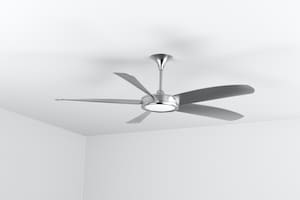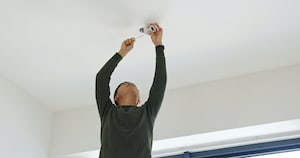Have you ever wondered how much weight a ceiling fan can hold? Maybe you’re decorating your home and have questions about what you can potentially hang from your ceiling fan. Or perhaps you’re hanging a ceiling fan from an electrical box. It’s important to make proper calculations before proceeding with ceiling fan installation.
How Much Weight Can a Ceiling Fan Hold?
 So, how much weight can a ceiling fan hold? It’s essential to clarify a few things when trying to hang anything. First, you should know that if you hang anything from a light fixture or ceiling fan, the weight considerably depends on the ceiling fan box. Each ceiling fixture box is rated through the manufacturer and is required to be pre-tested at an independent testing facility. Different ceiling fan design types have different weights that they can support.
So, how much weight can a ceiling fan hold? It’s essential to clarify a few things when trying to hang anything. First, you should know that if you hang anything from a light fixture or ceiling fan, the weight considerably depends on the ceiling fan box. Each ceiling fixture box is rated through the manufacturer and is required to be pre-tested at an independent testing facility. Different ceiling fan design types have different weights that they can support.
However, it’s essential that you know you generally shouldn’t hang anything from the ceiling fan itself. If you are decorating, you can add lightweight decor (like mistletoe or a paper product). The initial electrical box may not have been designed or intended to hold any additional weight.
Second, the weight of a ceiling fan itself can sometimes be too much for electrical boxes and depend on how they’re mounted. That’s why you must mount a ceiling fan correctly.
Ceiling Fan Electrical Boxes
First and foremost, you need to know whether or not the electrical box can hold the weight of your ceiling fan. The National Electrical Code requires protective boxes for electrical connections in any residential or commercial building. Often, those boxes support an electrical fixture as well. Typically, electricians use metal and plastic boxes. Plastic electrical boxes are often preferred because they’re cheap, relatively inexpensive, easy to use, and naturally insulated. However, they aren’t made to support a lot of weight and should not be used to support a ceiling fan. If they’re used, they can eventually wear down and crack. This can lead to the fan falling.
In many cases, electricians install a rough-in electrical box before hanging a ceiling fixture. This is usually round and attaches to the ceiling joist with nails or screws and can be made of metal or plastic. If the fixture weighs less than 5 lbs., it’s possible to replace the electrical box with a remodeling box. This type of box anchors directly to the drywall and is usually made of plastic.
Looking in the attic can help you to determine how to best support a ceiling fan that you want to install. You may not need to attach the box to the joist but could add additional two-by-sixes between joists and add your box to the desired location. You can also use a rod system to adjust the box’s position on the rods and then attaching the rods to the joists.
How Much Does a Ceiling Fan Weigh?
While on the topic of how much weight a ceiling fan can hold, how much do fans themselves weigh? Typically, a ceiling fan weights between 8 lbs. to 50 lbs. when fully assembled. Many junction boxes can support this weight while the fan is hanging still. However, a fan that functions as it typically operates puts additional stress on the object from which it is turned. The vibration and movement of the fan add to the downward force exerted on the box. Also, the downward force is directly related to the length of the blades. The larger the blade length, the greater the downward force is. Conventional metal or plastic boxes aren’t made to hold any more than 50 lbs.
What to do Before Mounting a Ceiling Fan
There are different ways of preparing to mount a ceiling fan. If you are renovating or constructing a building, you can easily plan out adding one. However, it’s different when you want to add one to an already existing residential or commercial building. Before you start, you’ll want to have researched a few things. You’ll want to know the limits of the electrical box you plan on using or the one currently being used. That will tell you how much weight it can support. Research the various types of ceiling fixtures and decide which one can be hung by the electrical box. Gather the tools you’ll need for the job, including a drill, Phillips and flat head drill bits or screwdrivers, and a ladder. You may also need wire strippers. You’ll also want to have a basic knowledge of the electrical wiring in your light fixture (typically, three wires, one being the ground wire) and how your breaker panel works.
How to Mount a Ceiling Fan
 The first step is to turn off the electrical power before you begin anything. After you’ve turned off the power, confirm that the power has been turned off by flipping the wall switch. Second, unpack the ceiling fan from its packaging and read the owner’s manual or installation guide. If you have a current ceiling fan, remove the existing light fixture with the appropriate tools. Next, you’ll install the ceiling fan bracket or mounting plate. Use your electric screwdriver or drill with the proper drill bit to attach the bracket to the junction box or ceiling joist. This mounting plate is usually provided with the ceiling fan you purchase. Ensure that you install it securely. If done incorrectly you may be contacting your local insurance agent after a accident.
The first step is to turn off the electrical power before you begin anything. After you’ve turned off the power, confirm that the power has been turned off by flipping the wall switch. Second, unpack the ceiling fan from its packaging and read the owner’s manual or installation guide. If you have a current ceiling fan, remove the existing light fixture with the appropriate tools. Next, you’ll install the ceiling fan bracket or mounting plate. Use your electric screwdriver or drill with the proper drill bit to attach the bracket to the junction box or ceiling joist. This mounting plate is usually provided with the ceiling fan you purchase. Ensure that you install it securely. If done incorrectly you may be contacting your local insurance agent after a accident.
Next, you’ll compose the fan motor and down rod. Feed the wire coming from the motor through the center of the new fixture’s canopy and rod. Make sure to tighten the provided screws properly. Secure the blade iron to each fan blade. To help support the fan while you connect the wiring, hook one side of the canopy onto the ceiling plate. Connect the correlating wires to their appropriate colors. If necessary, you can use wire strippers to strip the excess insulation from the wires. You’ll tape them with electrical tape and put a plastic connector at the end to cap it off. The green wire is usually connected to the ground. If not, a bare copper wire is used to ground the fixture.
Once your wires are connected and capped, place them inside the fixture and attach the canopy plate to the electrical box. Attach the fan blades to the fan motor using the proper tools. If your ceiling fan has a light, attach it next to the motor. After connecting it, put the lighting wires with the motor wires from the underside of the fan’s motor. Finally, after your light assembly is secured, add your light bulbs! Add the glass shade and pull cord to the fixture. Test your new ceiling fan by turning on the electrical power back on at the electrical panel. Switch on the wall switch to confirm that the power was correctly connected and works.
Even if this isn’t precisely how your ceiling fan or fixture needs to be attached, this is a general step-by-step process for hanging a ceiling fan. Your ceiling fan will come with an owner’s manual or installation guide to help you navigate installation.
How to Fix Loose Light Fixtures
If your current light fixture has come loose, you’ll want to secure it properly. It may have come loose after years of movement and vibration, which has caused the screws to unscrew themselves. If there isn’t anything solid near your fixture, it can be tempting to try and attach it to the drywall, but that could lead to a disaster and is a code violation. Light fixtures must be secured to an electrical box that is nailed to a stud or rafter. However, if you have a light fixture that doesn’t weigh much, you can reinstall it using a remodeling box that anchors to the drywall. If the fixture is too heavy, it must be supported by an electrical box connected to a stud, rafter, or joist. This could mean that you may need to change the position of the fan.
 If you need to fix a loose light fixture, turn off the electrical panel breaker switch. Remove the fixture and access the wire connection. Remove the wire caps and untwist them. If you do not have an electrical box installed, install one for future use. If the fixture is light, install a remodeling box anchored to the drywall. You’ll want to feed the wires before you anchor the box to the drywall.
If you need to fix a loose light fixture, turn off the electrical panel breaker switch. Remove the fixture and access the wire connection. Remove the wire caps and untwist them. If you do not have an electrical box installed, install one for future use. If the fixture is light, install a remodeling box anchored to the drywall. You’ll want to feed the wires before you anchor the box to the drywall.
However, if the fixture is too heavy, you may have to relocate it. If you have access to the attic, you’ll be able to avoid needing to relocate it. You can purchase a ceiling box with telescoping strapping explicitly designed for hanging ceiling lights between rafters. After cutting the appropriate hole for the telescoping strapping, feed the circuit cable through the back of the box. Do this for either box you install. Install an adapter plate, also called a crossbar, to the box with holes that line up with the screw holes on the light fixture base. Connect the wires again and cap them. Then, reassemble the fixture.
Disclaimer
You should never hang something over the weight limit to a fan. If you are considering trying to hang yourself from a light fixture, do not do so. Attempting this can lead to harm to yourself, your light fixture and could lead to death. A ceiling fixture cannot support an adult person’s weight and is likely to fall and injure you. If you are considering taking your own life, please call the National Suicide Prevention Lifeline: 1-800-273-8255.
